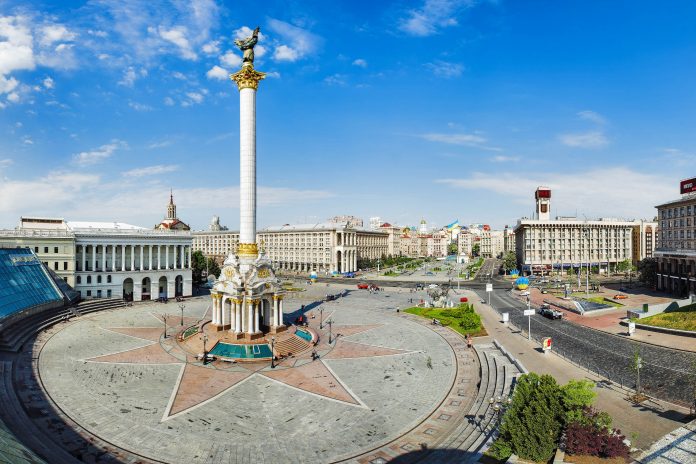Der Majdan Nesaleschnosti ist der zentrale Platz der ukrainischen Hauptstadt Kiew. Zu sehen gibt es Denkmäler, Springbrunnen, einen Hotelklotz, neoklassizistische Gebäude und ein unterirdisches Einkaufszentrum. Weltberühmt wurde er durch die wochenlange Besetzung während der Orangen Revolution im Jahr 2004, sowie aufgrund heftiger Straßenschlachten zehn Jahre später.
Der Majdan Nesaleschnosti (auch Maidan geschrieben), zu deutsch „Platz der Unabhängigkeit“, befindet sich Zentrum der ukrainischen Hauptstadt Kiew. Vor allem seit der Orangen Revolution im Jahr 2004 ist der Majdan Nesaleschnosti weltweit bekannt und ein absolutes MUSS für jeden Kiew-Besucher.
Der Majdan Nesaleschnosti hatte bereits viele Namen. Zur Gründungszeit von Kiew Mitte des 19. Jahrhunderts hieß er „Chreschatyki“, danach „Dums’ka“, als er Sitz des Duma (Stadtrates) wurde.
Nach der Oktoberrevolution hieß der Platz „Sowjetska“, ab 1935 „Kalinin-Platz“ nach dem Politiker Mikhail Kalinin und von 1977 bis 1992 „Platz der Oktoberrevolution“. Auch sein Erscheinungsbild hat sich im Lauf der Jahrzehnte stark verändert.
Seine erste Glanzzeit erreichte der Maidan Nesaleschnosti während der Industriellen Revolution, als Kiew die drittwichtigste Stadt im Russischen Reich war.
Im Zweiten Weltkrieg wurde er wie das gesamte Stadtzentrum von Kiew schwer beschädigt und völlig neu gestaltet. Damals war in der Gestaltung des Majdan Nesaleschnosti die sowjetische Handschrift deutlich zu sehen, mitten auf dem Platz prangte ein gewaltiges Lenin-Denkmal, welches jedoch nach dem Zerfall der Sowjetunion wieder abgerissen wurde.
Das letzte Mal wurde der Majdan Nesaleschnosti 2001 im Zuge des 10-Jahresfeier der Unabhängigkeit der Ukraine neu gestaltet.
Pionier: Im Jahr 1894 führte die erste elektrisch betriebene Straßenbahn im gesamten Russischen Reich direkt zum Majdan Nesaleschnosti.
Unruhen am Majdan Nesaleschnosti
Der Majdan in Kiew war immer wieder Schauplatz politischer Demonstrationen, so zum Beispiel die Studentenrevolten und Hungerstreiks im Jahr 1990, die zur Abdankung des damaligen Premier-Ministers Vitaly Masol führten.
Die bekannteste Demonstration am Kiewer Maidan war wohl jene im Jahr 2004 im Zuge der Orangen Revolution, als Hunderttausende wochenlang trotz Schnee und Kälte in Zelten den Platz besetzten und gegen den Wahlbetrug bei den ukrainischen Präsidentschaftswahlen protestierten.
Ebenfalls in die Schlagzeilen kam der Majdan Nesaleschnosti Mitte Februar 2014, als sich Demonstranten mit der Polizei und dem Militär heftige Straßenschlachten am Rande eines Bürgerkrieges lieferten und über 70 Todesopfer zu beklagen waren. Der Konflikt startete bereits im Dezember 2013 nach der Entscheidung der Kiewer Führung, das mit der EU geplante Assoziierungsabkommen vorerst auf Eis zu legen. Die Unruhen endeten Ende Februar, als Präsident Janukowitsch sein Amt niederlegte und aus Kiew floh. Am 21. Februar 2014 haben Regierung und Opposition ein Abkommen unterzeichnet.
Imposante Architektur am Majdan Nesaleschnosti
Durch die Hauptstraße von Kiew, die Chreschtschatyk, wird der Platz eine nördliche und eine südliche Hälfte getrennt. Der südliche Teil ist an die 70m breit und wird von drei Springbrunnen und einem über 60m hohen Unabhängigkeitsdenkmal in seiner Mitte geschmückt. Auf einem der Brunnen sind die vier legendären Gründer Kiews, Kyj, Schtschek, Choriw und Lybid, in Statuen verewigt, über deren Köpfen die ukrainische Nationalflagge flattert.
Von einem Hang aus überblickt das kolossale 68stöckige Hotel „Ukrajina“, das ehemalige Hotel „Moskwa“, den Platz, im Westen thront das Gebäude der Nationalen Musikakademie und ihm gegenüber wurde ein gigantischer TV-Schirm für wichtige Übertragungen aufgestellt. Das Bodenpflaster besteht aus Granitplatten, die mit ukrainischen Stickereimustern geschmückt sind.
Die Nordseite des Majdan Nesaleschnosti wird von mehreren Gebäuden flankiert, die alle im Stil des sowjetischen Realismus errichtet wurden. Von hier zweigen sternförmig fünf Straßen ab, die zu weiteren Sehenswürdigkeiten Kiews, wie zum Beispiel der Sophienkathedrale oder dem Michaelkloster führen.
Das Denkmal in der Mitte des Platzes stellt hier den Erzengel Michael, den Schutzpatron der Stadt dar. Auch hier befinden sich mehrere Springbrunnen, sowie das neoklassizistische Hauptpostamt Kiews und das Haus der Gewerkschaften.
Unterhalb des Platzes befindet sich das „Globus“, ein modernes fünfstöckiges Einkaufszentrum mit Restaurants, westlichen Shops und ukrainischen Ständen. Seine Oberlichter sind als gläserne Kuppeln auf dem Majdan Nesaleschnosti zu sehen.
Mittelpunkt von Kiew
Der Majdan Nesaleschnosti kann mit der Metro gut erreicht werden und ist nicht nur das räumliche, sondern auch das soziokulturelle Zentrum von Kiew. „Sehen und gesehen werden“ ist hier das Motto der Flanierenden, Shoppingwütigen und Flirtenden.
Der zentrale Platz ist der perfekte Ausgangspunkt für eine Stadtbesichtigung ist daher so gut wie zu jeder Tages- und Nachtzeit bevölkert. Beinahe täglich werden diverse Veranstaltungen abgehalten. In der Nacht ist der Majdan Nesaleschnosti fantastisch beleuchtet.
Alles in allem kann man sagen, wer in Kiew Urlaub macht, muss den Majdan Nesaleschnosti unbedingt gesehen haben. Man braucht sich aber nicht länger als eine halbe Stunde dort aufzuhalten.





